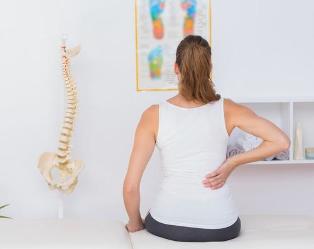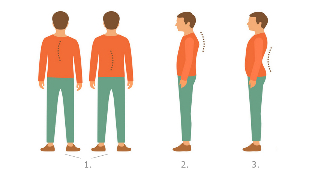Under a correct posture means the ability of man to maintain the body in a standing position at ease, not straining the muscles. Each of us is worth and sits in a particular position, the adoption of which occurs out of habit. As a direct physiological is this position, and determines the degree of "correctness" posture.

The formation of posture occurs during childhood, but this does not mean that an adult cannot correct your posture, get rid of violations and to reach a correct position of the body. Also, "spoiling" the posture is possible and in adulthood: for example, in the sedentary work, and a small mobile style of life. Curvature of the spine can lead to painful sensations and diseases, and become the cause of deterioration of the appearance of a person.
The causes and the consequences of a wrong posture
In normal physiological curves of the spinal column has in lumbar and thoracic departments. However, these curves can be violated, reinforced, smoothed.
Among the main causes of these problems can be attributed to the following:
- injury birth;
- uncomfortable desks and too heavy backpacks during the study period in the school;
- the fall in early childhood, have led to receiving a small value of injuries;
- incorrect gait and posture during the childhood that they checked and they did not have the parents/teachers;
- small physical activity, which is the cause of a weakening of the muscular corset;
- long shelf life incorrect posture (more often – in the case of performance of work);
- uncomfortable, not able selected shoes and clothing, the servant to take an incorrect position of the body;
- oncology, infectious diseases and other disorders that affect the condition of the spinal column;
- a variety of injuries.
The consequences of incorrect posture can be divided into several types:
- Scoliosis – lateral curvature of the vertebral column, divided in the frontal plane.
- Kyphosis – curvature of the thoracic spine towards the back in the sagittal plane.
- Lordosis – curvature of the spinal column in the lumbar spine forward in the sagittal plane.

As has already been observed, posture problems often take root in childhood. And last but not least the role they play in this school backpacks, kids are forced to wear every day. The doctors have found that the wearing of the portfolio has not impacted on the condition of the spinal column of the baby, its weight should not exceed 10-15% of the weight of the child.
In addition, incorrect posture often lead to degenerative and dystrophic diseases, which lead to limiting the mobility, the painful sensations and also the disorders of the functioning of the entire musculoskeletal system. It is osteochondrosis, osteoarthrosis, and even among vertebrates hernias.
If we talk about the aesthetic consequences of a wrong posture, you may notice slouching shape concave to the inside of the chest, convex, and because it's visually more voluminous belly, and many other unpleasant changes in the appearance of a person.
What should be the correct posture
Check, how correct you posture, is quite simple. Прислонитесь to the wall with the back and pay attention to the position of the heels, calves, buttocks, shoulders and neck. All of these parts of the body must also come in contact with the wall, and you should not apply the effort, the muscle tension in order to achieve this effect. Otherwise, you can talk about the fact that you have a poor posture.
A simple test would be to ask someone to take the picture with the back. Then on a photo scroll through straight sections of three lines: the ankles, the pelvis and shoulders. These three features must be parallel to each other, otherwise you cannot speak of the presence of curvature.
The main features correct, the correct posture can be attributed to the following:
- Taut, flat belly. Of course, the appearance of the belly also depends on the physique of a person, however, the correct posture always makes us more visually thin in this field.
- A small bulge in the chest area. Not worth the effort to do the "chest out" or, conversely, to align the back, as if she had nailed the board. Correct posture certainly includes small natural curves of the spine.
- The vertical position of the head.
- Assigned back and a little put down of the shoulders. Not worth the effort to bring the shoulder blades or too much lift off your shoulders, as well as it is, even in this case, unnatural to the spinal column.
- A bit of a twist of the foot to the knee, lightweight, "flies" pace.
The use of correct posture
- improvement of the functioning of many organs and internal systems, and, consequently, the improvement of the general well-being;
- removal of discomfort, pain in the upper part of the body (back, shoulders, neck);
- prevention of scoliosis, osteoporosis, and other diseases that make a person look unattractive and undermine its health;
- to avoid the formation of the so-called "beer belly", which are not immune, not even the people is complexion;
- improvement in mental activity, the ability to concentration;
- increase the self-esteem, the formation of a healthy self-confidence, which is so necessary for the achievement of the objectives.
The great enemy of a proper posture is high heel shoes. Walking in a shoe inevitably leads to a change in tilt of the body, which leads to the rupture of the posture and also the birth of systematic pain in the lower back. And those of the fairer sex, who regularly wear high-heels, can with time and do not earn the hernia of the intervertebral disc.
Simple exercises to improve posture
As has already been observed, incorrect posture – this is not a sentence even for an adult. Its can be regular, and with their own forces, with the use of clear and simple exercises. They are suitable for those who are of deviation from the correct position of the spinal column, not yet developed into serious chronic diseases, such as scoliosis. Otherwise, improve posture it is also possible, but already in the scope of special treatments complex.
The starting position for the first exercise of the group – the one that during the verification of the correctness of the posture. Прислонитесь to the wall so that your heels, calves, buttocks, pale and also the nape of the neck touched (for a person with posture problems conservation of this provision requires muscular efforts).
After having taken this position, follow these steps:
- Just hold the pose for three to five minutes.
- Keeping all the above listed points of contact of the body with the back, lift alternating legs, bending their knees. Perform the exercise for 10 times for each leg.
- Run, to turn, you tilt to the right and to the left (10 times in each direction), trying not to break the contact with the heels, calves, buttocks, shoulders and nape of the neck with a wall.
- Squat to the wall, keeping all the points of body contact with the wall. In other words, you should "glide" down along the wall, and then at the same way up to the top. 10 repetitions of the exercise will be enough.
A good way to correct posture is swimming. When a person is in the water, gravity loads on his spine is greatly reduced. Thanks to this, it strengthens the muscular structure of the spine, improves the tone near the muscles, vertebrae, and also the muscular lumbar and thoracic. All this has a beneficial effect on posture.
If you seriously intend to achieve a significant improvement of the posture, it is not superfluous to also do muscle-strengthening frame.
This is well suited to the following exercises:
- normal push-ups from the floor;
- conservation poses a "belt" for 30-60 seconds (under the "belt" refers to the maintenance of the body in an upright position when resting on only socks and forearm);
- exercise "boat" (simultaneous lift of both hands and both feet from a position lying on belly);
- hold dumbbell in the raised and hands at shoulder height (the exercise is performed in the sitting position, hold a dumbbell in need of 5-7 seconds for a climb).

























